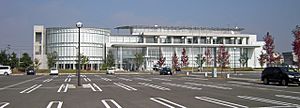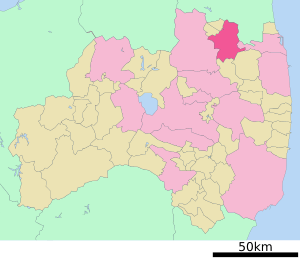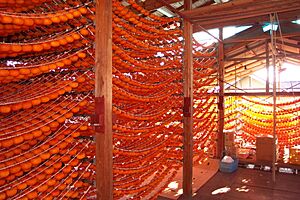Date, Fukushima facts for kids
Quick facts for kids
Date
伊達市
|
|||||||||||||
|---|---|---|---|---|---|---|---|---|---|---|---|---|---|

Date City Hall
|
|||||||||||||
|
|||||||||||||

Location of Date in Fukushima Prefecture
|
|||||||||||||
| Country | Japan | ||||||||||||
| Region | Tōhoku | ||||||||||||
| Prefecture | Fukushima | ||||||||||||
| Area | |||||||||||||
| • Total | 265.12 km2 (102.36 sq mi) | ||||||||||||
| Population
(May 31, 2020)
|
|||||||||||||
| • Total | 59,625 | ||||||||||||
| • Density | 224.898/km2 (582.484/sq mi) | ||||||||||||
| Time zone | UTC+9 (Japan Standard Time) | ||||||||||||
| Phone number | 024-575-2570 | ||||||||||||
| Address | 180 Hobaramachi aza Funabashi, Date-shi, Fukushima-ken 960-0692 | ||||||||||||
| Climate | Cfa | ||||||||||||
|
|||||||||||||
Date (伊達市, Date-shi) is a city in Fukushima Prefecture, Japan. As of May 31, 2020, about 59,625 people lived here in 22,843 homes. The city covers an area of about 265.10 square kilometres (102.36 sq mi).
Contents
Exploring Date City's Geography
Date City is located in the eastern part of the Fukushima Basin. This area is in the northern part of Fukushima prefecture. Miyagi Prefecture is just north of Date City.
Long ago, Date City was known for making silk. Later, people started growing fruits instead. Today, the city is made up of five former towns: Date, Hobara, Yanagawa, Ryozen, and Tsukidate. Each of these towns still has its own special traditions and events. Hobara is the main area where the city government is located.
- Rivers flowing through Date City include the Abukuma River and the Hirose River.
Nearby Towns and Cities
Date City shares borders with several other places:
- In Fukushima Prefecture:
- In Miyagi Prefecture:
- Shiroishi
- Marumori
Date City's Climate
Date City has a humid climate, which means it gets a good amount of rain. The average temperature each year is about 12.8 °C (55.0 °F). The city gets about 1,227 mm (48.3 in) of rain every year. September is usually the wettest month.
The warmest month is August, with temperatures around 25.5 °C (77.9 °F). The coldest month is January, with temperatures around 1.4 °C (34.5 °F).
| Climate data for Yanagawa, Date (1991−2020 normals, extremes 1976−present) | |||||||||||||
|---|---|---|---|---|---|---|---|---|---|---|---|---|---|
| Month | Jan | Feb | Mar | Apr | May | Jun | Jul | Aug | Sep | Oct | Nov | Dec | Year |
| Record high °C (°F) | 16.6 (61.9) |
21.5 (70.7) |
25.4 (77.7) |
32.2 (90.0) |
35.9 (96.6) |
36.6 (97.9) |
39.1 (102.4) |
40.0 (104.0) |
36.7 (98.1) |
30.8 (87.4) |
26.0 (78.8) |
20.9 (69.6) |
40.0 (104.0) |
| Mean daily maximum °C (°F) | 5.9 (42.6) |
7.2 (45.0) |
11.2 (52.2) |
17.7 (63.9) |
23.0 (73.4) |
25.7 (78.3) |
28.9 (84.0) |
30.4 (86.7) |
26.2 (79.2) |
20.6 (69.1) |
14.6 (58.3) |
8.7 (47.7) |
18.3 (65.0) |
| Daily mean °C (°F) | 1.3 (34.3) |
2.0 (35.6) |
5.2 (41.4) |
10.9 (51.6) |
16.4 (61.5) |
20.1 (68.2) |
23.7 (74.7) |
24.9 (76.8) |
20.9 (69.6) |
14.8 (58.6) |
8.6 (47.5) |
3.6 (38.5) |
12.7 (54.9) |
| Mean daily minimum °C (°F) | −3.0 (26.6) |
−2.6 (27.3) |
−0.4 (31.3) |
4.6 (40.3) |
10.3 (50.5) |
15.5 (59.9) |
19.8 (67.6) |
21.0 (69.8) |
16.7 (62.1) |
9.9 (49.8) |
3.2 (37.8) |
−1.0 (30.2) |
7.8 (46.1) |
| Record low °C (°F) | −12.6 (9.3) |
−12.1 (10.2) |
−10.2 (13.6) |
−4.4 (24.1) |
0.4 (32.7) |
5.8 (42.4) |
10.3 (50.5) |
11.6 (52.9) |
5.7 (42.3) |
−1.7 (28.9) |
−5.2 (22.6) |
−16.2 (2.8) |
−16.2 (2.8) |
| Average precipitation mm (inches) | 49.9 (1.96) |
33.0 (1.30) |
64.1 (2.52) |
75.1 (2.96) |
83.0 (3.27) |
109.4 (4.31) |
159.2 (6.27) |
143.9 (5.67) |
158.4 (6.24) |
123.4 (4.86) |
52.3 (2.06) |
41.5 (1.63) |
1,095.4 (43.13) |
| Average precipitation days (≥ 1.0 mm) | 7.9 | 6.5 | 8.2 | 8.0 | 8.9 | 10.8 | 13.2 | 10.7 | 11.0 | 8.7 | 6.7 | 8.1 | 108.7 |
| Mean monthly sunshine hours | 133.2 | 142.5 | 172.1 | 186.6 | 192.0 | 145.5 | 135.6 | 157.3 | 127.1 | 132.0 | 127.6 | 119.2 | 1,765.3 |
| Source: Japan Meteorological Agency | |||||||||||||
Date City's Population Over Time
The number of people living in Date City has slowly gone down over the last 70 years.
| Historical population | ||
|---|---|---|
| Year | Pop. | ±% |
| 1950 | 80,527 | — |
| 1960 | 76,361 | −5.2% |
| 1970 | 73,767 | −3.4% |
| 1980 | 74,186 | +0.6% |
| 1990 | 74,200 | +0.0% |
| 2000 | 71,817 | −3.2% |
| 2010 | 66,027 | −8.1% |
| 2020 | 58,240 | −11.8% |
A Look at Date City's History
Long, long ago, during the Stone Age, the first people are believed to have lived in the area that is now Date City.
In 1984, a complete skeleton of an ancient sea creature called Paleoparadoxia was found in Yanagawa. This amazing fossil is known as the "Yanagawa Specimen."
Later, the area became part of an old Japanese province called Mutsu. Towards the end of the Heian Period (around 794-1185 AD), the Date clan was founded here by Date Tomomune. The 17th leader of this clan, Date Masamune, later moved and became famous for founding the city of Sendai.
Date City was formed on January 1, 2006. This happened when five towns – Date, Hobara, Ryozen, Tsukidate, and Yanagawa – merged together.
Date City is about 60 kilometres (37 miles) northwest of the Fukushima I Nuclear Power Plant. After the 2011 earthquake and tsunami, there was a nuclear accident there. Even though Date City was outside the main danger zone, people, especially children, were asked to stay indoors for a while to be safe.
In 2016, an anime cartoon was made to promote the city. It's called Masamune Datenicle. It features a young Date Masamune who gets special powers from a dragon to call on past leaders of the Date Clan.
Date City's Economy
The main way people in Date City make a living is through farming. They grow a lot of rice and fruits. The city is especially known for its delicious peaches and dried persimmons.
A company called Taiyo Yuden also has a factory in Date City. It makes parts for electronics. In the past, this factory also made CDs, DVDs, and Blu-ray discs.
Delicious Peaches
Date City is in the middle of the Fukushima Basin, which is a great place for growing peaches. The most popular kinds of peaches grown here are Akatsuki, Kawanakajima, and Yuuzora.
Special Dried Persimmons
When silk production became less popular, the village of Isazawa in Yanagawa started focusing on making dried persimmons. People had been drying persimmons here since the Edo Period (1603-1868).
A special way of drying persimmons, similar to how raisins are made in the United States, was introduced. This method uses sulfur fumigation. It makes the dried persimmons much sweeter and softer. These special persimmons are called anpogaki or tsurushigaki. They are bright orange, unlike traditional dried persimmons (hoshigaki) which are tough and almost black.
After the 2011 disaster, making anpogaki stopped for three years. But now, the persimmon farms in Date City have been cleaned. Machines are used to test the fruit, making sure the final product is safe to eat.
Learning in Date City
Date City has many schools for students of all ages. There are fourteen public elementary schools, six public junior high schools, and two high schools (one public and one private).
| Area | Public/Private | School |
|---|---|---|
| Date | Public | Date Elementary (伊達小学校) |
| Public | East Date Elementary (伊達東小学校) | |
| Yanagawa | Public | Yanagawa Elementary (梁川小学校) |
| Public | Awano Elementary (粟野小学校) | |
| Public | Sekimoto Elementary (磧本小学校) | |
| Hobara | Public | Hobara Elementary (保原小学校) |
| Public | Ota Elementary (大田小学校) | |
| Public | Kamihobara Elementary (上保原小学校) | |
| Public | Hashirazawa Elementary (柱沢小学校) | |
| Ryōzen | Public | Kakeda Elementary (掛田小学校) |
| Public | Ishida Elementary (石田小学校) | |
| Public | Oguni Elementary (小国小学校) | |
| Public | ||
| Tsukidate | Public | Tsukidate Academy (月舘学園) formerly Tsukidate Elementary (月舘小学校) |
| Public |
| Area | Public/Private | School |
|---|---|---|
| Date | Public | Date Middle School (伊達中学校) |
| Yanagawa | Public | Yanagawa Middle School (梁川中学校) |
| Hobara | Public | Shōyō Middle School (松陽中学校) |
| Public | Tōryō Middle School (桃陵中学校) | |
| Ryōzen | Public | Ryōzen Middle School (霊山中学校) |
| Tsukidate | Public | Tsukidate Academy (月舘学園) formerly Tsukidate Middle School (月舘中学校) |
| Area | Public/Private | School |
|---|---|---|
| Hobara | Public | Date High School(福島県立伊達高等学校) formerly Hobara High School (福島県立保原高等学校) |
| Yanagawa | Public | |
| Date | Private | Seikō Gakuin High School (私立聖光学院高等学校) |
Fun Festivals in Date City
Date City hosts several exciting festivals throughout the year!
Summer Fun
Hobara Summer Festival
This festival happens every year in early to mid-August. It features the Hobara Yoitoko Dance and the Bon dance. There are also food stands, performances, and fun games called the Momo-Olympics where you can win prizes.
Tsukidate Summer Festival
The Otehime-no-sato Summer Festival is held around mid-August. You can enjoy fireworks, food stalls, and beautiful lanterns.
Autumn Celebrations
Hobara Autumn Festival
The Amaterasu Shinmeigu Shrine Autumn Festival takes place in mid-October. Local drumming groups perform on special floats along Jinya Street.
Ryōzen Fall Festival
The Ryōzen Shrine Fall Festival is another autumn event to enjoy.
Winter Events
Hobara Tsutsuko-biki Festival
This unique festival has been celebrated for over 300 years! It takes place every year at Itsukushima Shrine on the first Sunday of March. The main event is a three-way tug-of-war. Men dressed in traditional clothing pull a heavy bundle. After a winner is decided, they all work together to lift and drop the bundle. This action makes hot mochi (rice cakes) inside the bundle, which is then shared with everyone watching.
Getting Around Date City
By Train
![]() East Japan Railway Company (JR East) - Tōhoku Main Line
East Japan Railway Company (JR East) - Tōhoku Main Line
- Date
AbukumaExpress – Abukuma Express Line
- Takako - Kamihobara - Hobara - Ōizumi - Niida - Nitta - Yanagawa - Yanagawa Kibōnomori Kōen-mae - Tomino - Kabuto
By Road
Major roads connecting Date City include:
 Tōhoku-Chūō Expressway
Tōhoku-Chūō Expressway National Route 4
National Route 4 National Route 115
National Route 115 National Route 349
National Route 349 National Route 399
National Route 399
Cool Places to Visit in Date City
- Ryōzen Shrine: A historic shrine.
- Mount Ryōzen: A beautiful mountain that is both a National Historic Site and a National Place of Scenic Beauty.
- Miyawaki temple ruins: Ancient temple ruins that are a National Historic Site.
- Former Kameoka Family Home: A historical house.
- Takako Ni-juu Kyou: A scenic spot.
- Site of Takakogaoka Castle: This was the original home of the Date Clan.
- Takako Lake: A lovely lake, part of Takako Ni-juu Kyou.
- Site of Yanagawa Castle: This castle was built by the Date Clan and was once home to Date Masamune.
- Yanagawa Hachiman Shrine: A shrine where Date Masamune prayed for victory in battles.
Famous People from Date City
- Saitou Hikonai (1709-1750): A farmer who led a peasants' revolt.
- Seishiro Okazaki (1890-1951): A Japanese American healer and martial artist. He founded a style of jujitsu called Danzan-ryū. He was born in the village of Kakeda.
- Yahei Miura (1895-1971): A long-distance runner and Olympic athlete.
Date City's Global Connections
Date City has special connections with other places around the world:
 It is a sister city with Revere, MA, United States, since August 2016.
It is a sister city with Revere, MA, United States, since August 2016. It was a "Host Town" for the Republic of Guyana for the 2020 Tokyo Olympics starting in August 2019.
It was a "Host Town" for the Republic of Guyana for the 2020 Tokyo Olympics starting in August 2019.
See also
 In Spanish: Date (Fukushima) para niños
In Spanish: Date (Fukushima) para niños





